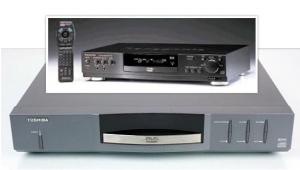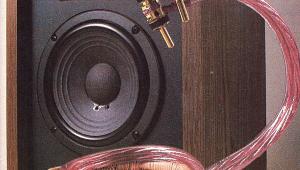Speaker Cables: Can You Hear the Difference? Page 3
It is important to emphasize again that these ratings and comments came from listeners who knew which cables they were listening to. The panelists’ strong pre-test biases in favor of Monster Cable could have influenced their reactions during the open listening tests no matter how conscientiously they tried to ignore them. Eliminating the listeners’ awareness of which cable was being auditioned was, therefore, a major consideration in our design of the controlled listening tests.
The Controlled Tests
The most striking result of the controlled listening tests (see Table
II) was the selecting out of the 24-gauge wire. All the comparisons
in which it was not matched in gain level with the other cables show
a high degree of statistical significance. With pink noise, every panelist was able to distinguish non-level-matched 24-gauge wire from either of the two heavier cables in at least twelve out of fifteen tries,
or 75 percent, which is an accepted threshold of significance in
psychoacoustical testing. Even when the levels were matched
between 24-gauge wire and Monster Cable (Comparison No. 2),
four listeners still heard a difference. While one listener might have just been making lucky guesses, it is very unlikely that four out of eleven were doing so.
It is reasonable to assume that because Monster Cable is thicker and has lower electrical resistance than 24-gauge wire, it is a more electrically “accurate” signal conductor. The audible differences between them in our controlled listening tests strongly suggest, therefore, that 24-gauge is too thin for optimal audio performance—in 30-foot lengths, at least.
When 16-gauge wire was pitted against Monster Cable using pink noise as the program material (Comparison No. 3), three of the panelists correctly identified it in twelve out of fifteen tries. Again, it is very unlikely that this could have occurred by chance (the odds are less than 1 in 999). But when choral music was used instead of pink noise (Comparison No. 5), none of the panelists correctly distinguished 16-gauge from Monster Cable to a psychoacoustically significant degree (75 percent of the time). This suggests that both 16-gauge and Monster Cable are fine conductors for music signals of typical complexity, but a very sensitive listener under the best conditions might find an audible difference—not necessarily a preference—between them on wide-band (pink-noise) test signals.
In sum, five out of the six sets of controlled listening compari- sons gave results that are statistically significant using the binomial distribution (see caption for Table II). In only two sets of comparisons, however—both testing 24-gauge wire against a heavier cable using pink noise—were the results above the stricter 75 percent threshold usually considered necessary to establish an audibly significant difference.
Comments
While it may not be news that the thin 24-gauge speaker cable sounded different from the other cables tested, what does this result mean in terms of cable measurements and their audible effects? A 1- to 2-dB decrease in sound level was measured for the 24-gauge wire during the pink-noise listening tests, and a number of panel members reported a loss of treble and bass response with 24-gauge during open listening. Was the wire also changing the perceived frequency balance?
Julian Hirsch’s measurements of the 24-gauge wire showed it to be much higher in resistance than Monster Cable or 16-gauge wire. Its 1.8-ohm resistance resulted in a 1.76-dB insertion loss with an 8-ohm resistive load, which means that fully one-third of the amplifier’s output was being dissipated by the cable over the 30-foot runs we used. This accounts for the unanimously audible decrease in level. Frequency response was also affected because the 24-gauge cable’s relatively high series resistance interacted with the system impedance of the KEF 105.2 speakers used in the tests to produce 1.25-dB frequency-response depressions at 100, 1,000, and 4,000 Hz. This perhaps explains the subjective impression that with the 24-gauge wire the sound was “duller.” Note that even in the double-blind, matched-level test of 24-gauge vs. Monster Cable (Comparison No. 2), four panel members heard differences. The level-matching procedure corrected only for an overall level mismatch, not for frequency-response changes caused by the 24-gauge wire.
The panelists’ initial preference for Monster Cable was only partly vindicated by their ability to distinguish it from 16-gauge cable in the controlled pink-noise test (Comparison No. 3). What the panelists noticed during this comparison was either the result of the measured 0.16-dB insertion-loss difference between the two cables or the corresponding 0.04-dB frequency-response variation when they were connected to the KEF 105.2 speakers. The former is far more likely.
It seems that tests with real music signals decrease the ability of listeners to distinguish small sonic differences between cables. Although three panelists heard a difference between 16-gauge and Monster Cable with pink noise, the panel as a whole was unable to hear any significant difference between them with choral music (Comparison No. 5). Even when Monster Cable was compared with 24-gauge using choral music (Comparison No. 6), only three panel members had psychoacoustically significant scores (twelve out of fifteen or better), though the group’s score in this non-level-matched comparison did reach the less strict level of “statistical significance.” It seems likely that the differences between 24-gauge and Monster Cable would be even harder to hear (if audible at all) if the levels were matched and typical music, not pink noise, were used.
Because of our short auditory memories, noticing very subtle sonic differences requires a more or less constant signal as well as instantaneous switching between the components being compared. One must wonder how real are the vast sonic differences reported in the underground audio press among such components as cables, preamplifiers, and power amplifiers, since the results derive from uncontrolled, non-level-matched listening tests using only wide-dynamic-range musical material.
The final significant conclusion one can draw from our data is that at least one genuine “golden ear” does exist. Listener J on our panel had 80 percent “hits” (psychoacoustically significant scores) with an average score of 12.7 (out of 15). Obviously, certain listeners—whether through talent, training, or experience—can hear small differences between components. But the majority of the panelists, although by no means poor or unskilled listeners, heard only differences resulting from the relatively large, easily measured variations in signal level and frequency response in the 24-gauge comparisons. Note, however, that J was the only panel member to score a hit for both music and level-matched pink-noise comparisons between Monster Cable and 24-gauge (Nos. 2 and 6). In these two tests only a third of the listeners achieved psychoacoustically significant scores, showing that the audible differences in these tests were not very obvious despite the overall statistical significance of the group’s scores.
Conclusions
Our tests were certainly not exhaustive, since only three different cables were compared. Yet
the results demonstrate that while Monster Cable and 16-gauge lamp cord are both audibly different from and probably superior to 24-gauge wire, 16-gauge is good enough to be indistinguishable from Monster Cable when playing music. An esoteric cable would have to be substantially better than Monster Cable in order to be demonstrably superior to 16-gauge wire. One of the listeners on the panel ran a quick but controlled listening test of Monster Cable against high-capacitance Mogami Cable (with its “damper” removed) and 8-gauge Levinson HF-lOC twin-lead, both products more costly than Monster Cable. He did no better in distinguishing Monster Cable from the other two than chance would allow.
So what do our fifty hours of testing, scoring, comparing, and listening to speaker cables amount to? Only that 16-gauge lamp cord and Monster Cable are indistinguishable from each other with music and seem to be superior to the 24-gauge wire commonly sold or given away as “speaker cable.” Remember, however, that it was a measurable characteristic—higher resistance per foot—that made 24-gauge sound different from the other cables. If the cable runs were only 6 instead of 30 feet, the overall cable resistances would have been lower and our tests would probably have found no audible differences between the three cables. This project was unable to validate the sonic benefits claimed for exotic speaker cables over common 16-gauge zip cord. We can only conclude, therefore, that there is little advantage besides pride of ownership in using these thick, expensive wires.
Laurence Greenhill is a research psychiatrist who is currently studying the effects of drugs on perception. He has been an audio enthusiast since the late Sixties and has written a number of articles on perception, audio, and subjective listening tests.























































